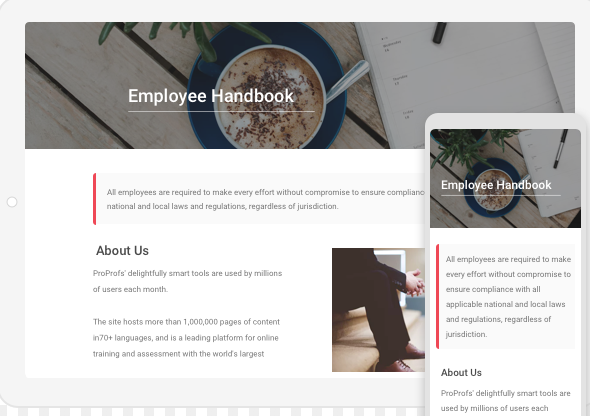
Key Takeaway:
- Staying up-to-date with local laws is crucial for compliance: It is important for businesses to understand the definition and significance of local laws and comply with them to avoid legal repercussions.
- Use of a digital employee handbook helps in compliance: Digital employee handbooks are comprehensive and easy-to-use resources that help employers comply with local laws by providing information on relevant laws and regulations.
- Regular updating of digital employee handbooks is necessary: Since local laws can change frequently, it’s essential to keep digital employee handbooks updated to ensure compliance and avoid legal issues.
Local Laws: Importance of Staying Up-to-Date with Your Digital Employee Handbook
The world of employment is constantly changing, and employers must stay up-to-date on local laws to create a safe and legally-compliant workplace. In this part of the article, I ll share my personal experience of how keeping my digital employee handbook in compliance with local laws has helped me to avoid legal penalties and improve my employees job satisfaction.
We ll start by exploring exactly what local laws are and why they matter so much for businesses. From there, we ll dive into the various ways that employers can ensure that they are complying with local laws, including through the use of digital employee handbooks.
Definition of Local Laws
As we go about our daily lives, it’s essential to understand how local laws work and why they are in place. Local laws refer to regulations and statutes created by local governments to govern specific areas within their jurisdiction. These laws may cover a wide range of issues, including public safety, environmental protection, zoning regulations, and business operations. Local laws operate based on the concept of home rule, which gives local authorities the power to make statutes that pertain to their respective communities’ unique needs. They have the ability to enforce these rules and procedures within the boundaries of their region or municipality. The primary goal behind creating these localized policies is to ensure compliance with state legislation while also providing tailored responses and solutions for regional challenges. The creation of local laws is an extensive process involving consultations with community leaders, residents, legal experts, stakeholders, and other interested parties. Municipalities must examine specific needs related to their district or geographic area before drafting localized legislation that best suits its residents’ needs.
Pro Tip: It’s always worth investigating your region’s local laws when you start a new job or move into a new neighborhood. This information will help you navigate your community safely without accidentally violating any local ordinances.

Significance of Complying with Local Laws
Complying with local laws is crucial for individuals, businesses, and society as a whole. Being aware of and adhering to local laws ensures that everyone is operating within the same framework, which promotes fairness and stability. Local laws are created specifically for a particular area and are designed to address unique challenges and concerns. Complying with them is essential because it reflects adherence to civic duty, respect for the community, and the promotion of overall public welfare.
The significance of complying with local laws is that it helps maintain social order and provides a level playing field for everyone. Local laws cover a wide range of issues, such as zoning regulations, employment policies, environmental standards, building codes, and more. They provide guidelines on how individuals and businesses should conduct themselves in ways that are acceptable to the community. When people follow these guidelines, it helps create an environment where everyone can feel safe and secure. For example, complying with environmental regulations means reducing harmful emissions or properly disposing of waste materials. These actions help protect natural resources like air and water quality while also promoting sustainable practices. Following safety regulations protects individuals from harm while ensuring that activities like development projects or industrial activities occur without adverse consequences for nearby communities. One valuable tip for complying with local laws is to regularly monitor updates or revisions to regulations. This information can be obtained through city hall websites or other official channels. Updates can impact legal obligations in areas such as tax compliance or zoning changes required by new ordinances. Now that we understand why complying with local laws is so critical, let’s dive into the essential aspects of your digital employee handbook – Do you know what your digital employee handbook should include? Let’s find out!
Understanding Your Digital Employee Handbook
When it comes to running a business, keeping up with changing laws and regulations is crucial. One way to stay in compliance is through a digital employee handbook. In this section, I d like to share my thoughts on the importance of understanding your digital employee handbook. We ll start by exploring the what and why of a digital employee handbook, and how it can help your business stay up-to-date with local laws. Then, we ll dive into the contents of a comprehensive digital employee handbook and what you should include to ensure your employees have clear guidelines and understanding of their rights and responsibilities.

What is a Digital Employee Handbook and Why Use it?
As workplaces change and adapt to keep up with the digital age, a new innovation has emerged that is designed to streamline and simplify an essential aspect of many businesses: the employee handbook. A Digital Employee Handbook is an electronic version of this crucial document that can be accessed from any device with internet connectivity. The digital nature of these handbooks allows them to be more interactive, easily updated, and more environmentally friendly than their paper counterparts.
Digital Employee Handbooks work by enabling companies to store all employee policies, procedures, and company information in one central location that is accessible to all employees. This can be especially useful for large companies or those with multiple locations where it may be difficult or time-consuming for employees to access a physical copy of a handbook. Moreover, since these documents are stored on secure servers, they are protected against loss or damage caused by natural disasters or fires.
Using a Digital Employee Handbook offers several benefits over traditional paper copies in terms of speed and accessibility. Employees can quickly navigate through the entire document using a search function if they need specific information about company policies, standards or procedures. Among other things, this feature guarantees that employees have instant access to any company policies changes without waiting for hard copies to arrive in their mailboxes.
One interesting fact about these handbooks is just how quickly they have become ubiquitous in modern workplaces. It was not very long ago when paper handbooks were the norm, but today there are numerous technological solutions which make it less cumbersome for both employers and employees equally. Additionally, staying up-to-date on local laws is paramount for businesses to avoid penalties. In recent years there has been a rapid rise in auto-updated digital handbooks as ensure compliance with ever-changing employment laws becomes easier. If you’re interested in learning more about Digital Employee Handbooks beyond what has already been discussed above a subject sure-fire way to strengthen your HR game I’ll delve into what makes an excellent Handbook below!
Contents of a Comprehensive Digital Employee Handbook
When it comes to a comprehensive digital employee handbook, there are many important things to consider. The contents of such a handbook must be able to provide all necessary information that an employee needs at each stage of their employment lifecycle. This includes anything from the onboarding process to pay and benefits, and even termination procedures. The handbook should also include policies and procedures, legal requirements, and compliance information.
Here is an example table of the contents of a comprehensive digital employee handbook:
| Contents | Description |
|---|---|
| Introduction | Welcome message from leadership |
| Company Overview | Mission statement, history, organizational structure |
| Employment Policies | Anti-discrimination, harassment policies |
| Compensation and Benefits | Salary rates, vacation/PTO policy, health plans |
| Performance Management | Evaluation criteria for both managers and employees |
| Safety Policies | Hazard communication program guidelines |
| Code of Conduct | Standards of behavior that must be followed by all employees |
| Termination Procedures | Exit interview return policy |
In addition to these standard sections, more comprehensive handbooks may contain additional information about training opportunities, communications standards (e.g., email etiquette), company culture or vision statements. All in all, it is crucial for the information provided within a digital employee handbook to cover every unique aspect of your respective company s culture.
A real-life example shows how important it can be to have a comprehensive digital employee handbook. In one case study from 2012 called Custom Building Products vs The American Worker/United Brotherhood Workers (CBP), CBP found itself embroiled in legal issues after terminating an employee who’d used bad language towards another worker. The termination had been carried out without following proper CBP procedure which resulted in legal action against them on behalf of the terminated worker. Therefore it’s no joke not staying up-to-date with local laws affecting your company because noncompliance could cause severe consequences particularly in such complicated disputes as described in the Custom Building Products case above. Ultimately it can affect a company’s bottom line too, any litigation issues could take up valuable time and resources that would be better spent on growth-enhancing ideas.
Importance of Updating Your Digital Employee Handbook with Local Laws
As someone who’s been in the HR industry for a few years now, I can’t stress enough the importance of staying on top of local laws when it comes to creating and maintaining a digital employee handbook. Without doing so, there could be severe repercussions for non-compliance that could ultimately harm the company’s reputation and financial standing. That’s why it’s crucial to understand the significance of updating your digital employee handbook with local laws.
In this section, we’ll discuss two sub-sections – firstly, the repercussions of non-compliance and secondly, techniques to keep your handbook up-to-date with the ever-changing local laws.

Understanding the Repercussions of Non-Compliance
Understanding the Repercussions of Non-Compliance is vital for any organization, as failure to comply with local laws can result in serious legal and financial consequences. Non-compliance is a violation of regulations or laws that govern various aspects of organizational operations, such as labor laws, data protection regulations, health and safety regulations, among others. In most cases, non-compliance occurs unintentionally due to lack of knowledge, negligence or oversight.
Non-compliance can lead to fines, lawsuits and reputational damage that can have long-lasting effects on an organization’s success. Fines for non-compliance with local laws can range from hefty monetary penalties to criminal prosecution. Additionally, lawsuits due to non-compliance could eat away at profits and drain resources intended for other crucial aspects of an organization’s operation.
Understanding the Repercussions of Non-Compliance requires organizations to be familiar with the specific regulations that apply to their business activities. Keeping up-to-date with local laws helps avoid potential compliance issues and ensures that organizations remain on the right side of the law.
Ensuring overall compliance is also essential when it comes to attracting new customers or investors who may be interested in knowing if an organization complies with relevant regulations. Non-compliant companies risk losing out on good business opportunities because many customers are now deliberate about choosing businesses that are responsible corporate citizens. Always remember – Laws are not made for breaking! Keep reading ahead for Tips on ways you can stay up-to-date about changing regulations without breaking a sweat!
Techniques for Keeping Your Employee Handbook Updated with Local Laws
Keeping your employee handbook updated with local laws is crucial for ensuring legal compliance and protecting your business from potential lawsuits. Techniques for achieving this include:
- Regularly reviewing and revising the handbook as necessary,
- Seeking the advice of legal professionals, and
- Tracking changes in local laws that may impact your policies.
One technique for staying up-to-date on local laws involves conducting regular audits of your employee handbook. During these audits, you can review each policy to identify any areas where updates are needed. Additionally, it’s important to have a system in place for communicating changes in local laws to relevant staff members so they can make necessary updates to policies.
To ensure your employee handbook accurately reflects local laws, it’s important to seek the advice of qualified legal professionals. You may also want to consult with an HR consultant or other industry experts who can offer guidance on best practices for updating company policies. Other valuable techniques for keeping your employee handbook updated with local laws include attending conferences or training sessions focused on HR topics or employment law. Additionally, you can survey employees periodically to gather feedback and identify areas where policies may need improvement. Failing to update your employee handbook with current local laws can result in serious consequences, including fines, legal disputes, and reputational damage. To avoid these risks, it’s important to prioritize staying informed about changes in employment law so you can keep your policies up-to-date and ensure compliance at all times. Don’t risk falling behind on important updates that could impact future decisions by ignoring the importance of updating your employee handbook with local laws. Take action today to ensure your policies are current and compliant with all relevant regulations.
Ready to learn more about the advantages of a digital employee handbook? See how digitizing your policies can streamline operations and improve accessibility for employees without sacrificing compliance.
Advantages of a Digital Employee Handbook
As a business owner, I know that keeping up-to-date on the latest laws and regulations can be a daunting task. However, one area where it s especially important to stay informed is in the creation and maintenance of an employee handbook. In today s digital age, a digital employee handbook can provide many advantages over the traditional paper version.
In this section, I ll explore the benefits of a digital employee handbook for both employers and employees, along with some tips and strategies for ensuring compliance with local laws and regulations when creating and updating your handbook. So grab your coffee and let’s dive into the world of digital employee handbooks.
Benefits for Employers and Employees
Benefits for Employers and Employees are vast when it comes to having a digital employee handbook. A digital handbook not only makes it easy to manage but also ensures that the employees have access to all the necessary information in real-time. Firstly, it saves time and money. The digital format eliminates the need for printing and distributing physical handbooks every time there is an update. Additionally, employers can easily make changes and distribute them efficiently without any delay or cost. Secondly, it improves consistency and reduces errors. Having an up-to-date digital handbook ensures that all employees receive the same information, reducing inconsistencies in communication across different departments or shifts. Furthermore, having error-free documents eliminates misunderstanding amongst employees concerning their job description. It is essential to stay up-to-date on state and federal laws for your digital employee handbook to avoid any legal issues in the future. Thirdly, a digital format ensures that regulations are adhered to. Employers need to comply with several local laws related to employment policies like wage rates, working conditions etc., shifting records from physical copies of handbooks to digital ones help employees access necessary policy documents quickly while helping employers maintain accurate records. Pro-tip: Make sure that your digital employee handbook is up-to-date and readily available on your website and intranet for your employees to stay compliant with local laws. reference whenever they require the information. Now that you have understood how important it is to have a Digital Employee Handbook let’s explore “Ways to Enhance Compliance with a Digital Employee Handbook” which will give you tips on how you can create an effective employee compliance system effortlessly.
Ways to Enhance Compliance with a Digital Employee Handbook
When it comes to enforcing compliance with a digital employee handbook, there are several ways to ensure success. The first is through providing regular training and education on the policies outlined in the handbook. This can be done through in-person sessions, online modules, or a combination of both. Secondly, it is important to make sure that every employee signs and acknowledges receipt of the digital employee handbook. This not only provides proof of compliance but also sets expectations for employees regarding their responsibility to follow company policies. The third way to enhance compliance is through making the handbook easily accessible and user-friendly. A well-designed digital handbook with a search function and clear outlines of policy categories makes it easier for employees to find and understand the information they need.
Fourthly, it is crucial to ensure that the content within the digital employee handbook is up-to-date and complies with all relevant laws and regulations. Regular reviews of the handbook should be conducted by HR professionals or legal experts to guarantee ongoing compliance.
Fifthly, creating consequences for non-compliance can encourage employees to take company policies seriously. These consequences should be clearly outlined in the digital employee handbook as well as at various stages throughout an employee’s time at the company. Lastly, management should lead by example when it comes to upholding company policies outlined in the digital employee handbook. When senior leaders demonstrate adherence to policies such as anti-discrimination measures or data privacy regulations, they set a precedent for other employees to follow suit. A true story about this heading involves an organization whose strict dress code was enforced using a digital employee handbook. Management found that simply having a policy in place wasn’t enough- some employees continued to disregard the dress code guidelines regularly until management began strictly enforcing penalties outlined within their digital policy manual for non-compliance. Once there were real consequences attached to breaking company policy, compliance rates improved significantly.
Five Facts About the Importance of Staying Up-to-Date on Local Laws with Your Digital Employee Handbook:
- Keeping up-to-date on local laws helps protect your business from legal liabilities and penalties. (Source: Forbes)
- Digital employee handbooks make it easier to update policies and ensure compliance with local laws. (Source: BambooHR)
- Staying informed on local laws helps create a safe and inclusive workplace environment for all employees. (Source: SHRM)
- Having a digital employee handbook that reflects local laws can also facilitate communication and transparency between employers and employees. (Source: Employment Law Handbook)
- Failure to comply with local laws can result in negative consequences for employee morale and retention, as well as company reputation. (Source: HR Technologist)
FAQs about The Importance Of Staying Up-To-Date On Local Laws With Your Digital Employee Handbook
What is the importance of staying up-to-date on local laws with your digital employee handbook?
The importance of staying up-to-date on local laws with your digital employee handbook is crucial to preventing potential legal actions against your company, ensuring compliance with regulations, and creating a safe and fair work environment for your employees.
What are some common local laws that employers need to be aware of?
Some common local laws Employers need to be aware of several local laws, such as minimum wage laws, anti-discrimination laws, sick leave laws, and worker’s compensation laws, among others.
What are the benefits of having a digital employee handbook for compliance with local laws?
The benefits of using a digital employee handbook make it easier to stay up-to-date on changing laws and regulations. It allows for quick updates and distribution to all employees, ensuring they are aware of any changes in local laws.
How often should an employer update their digital employee handbook with local law changes?
Employers should update their digital employee handbook with local law changes as soon as possible or at least every year to ensure it is current and accurate.
What are the consequences of not following local laws with your employee handbook?
If an employer does not follow local laws, it can lead to costly fines, legal action, and a damaged reputation. It may also lead to negative employee morale and turnover.
What resources can an employer use to stay up-to-date on local laws?
An employer can use resources such as the Department of Labor, local government websites, and legal counsel to stay up-to-date on local laws.